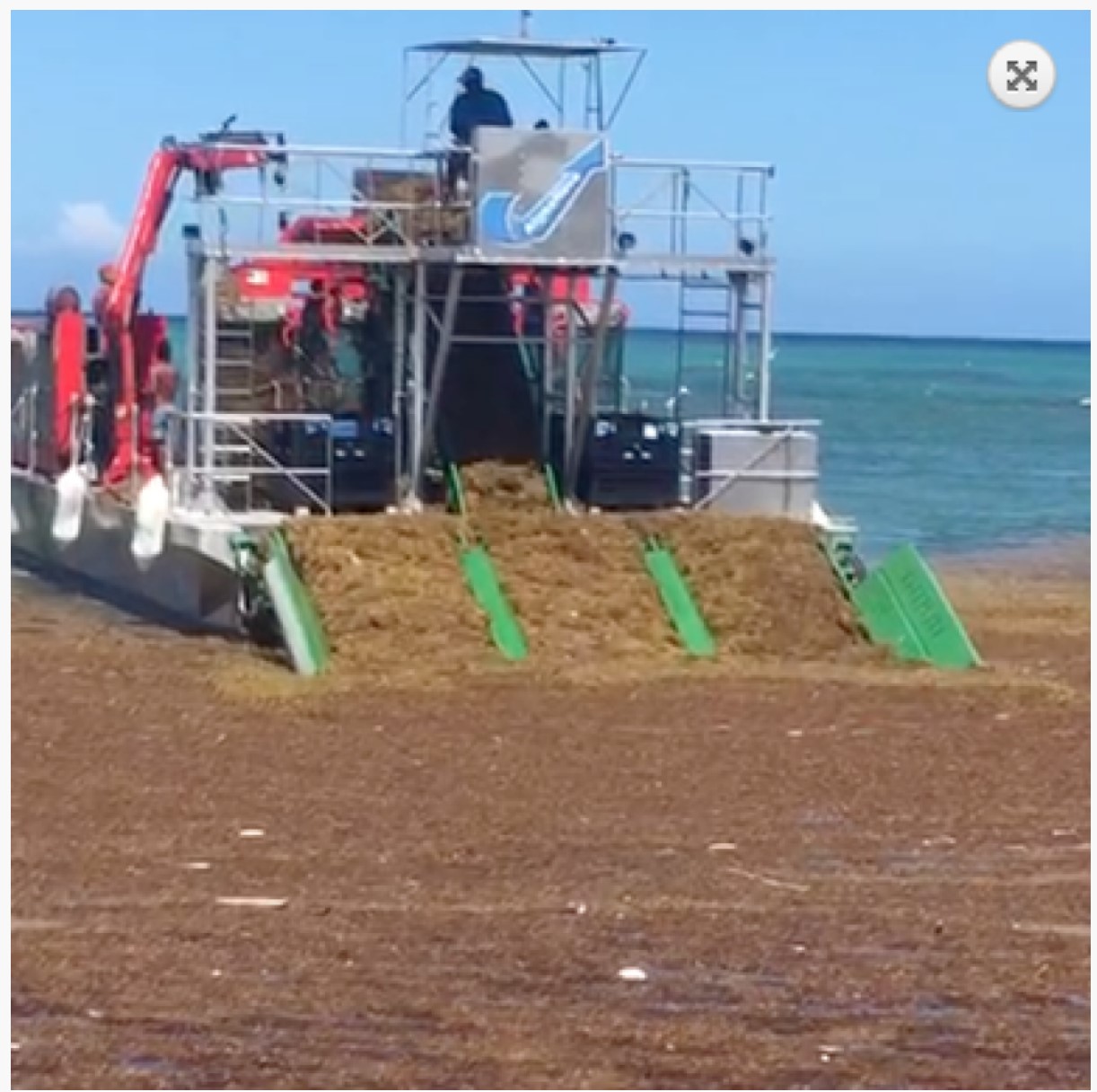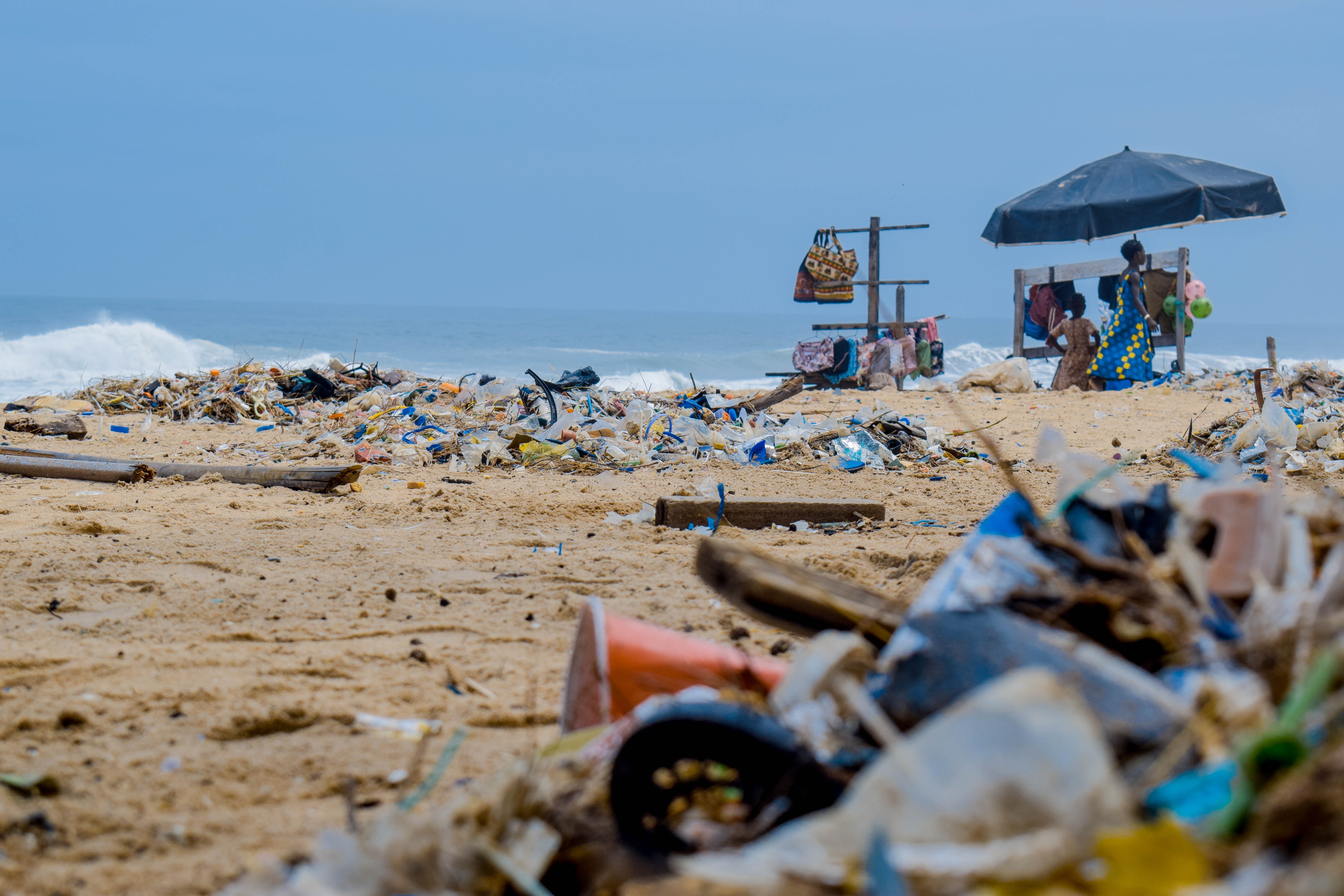

 |
 |
|



Welcome to BioCarbonDynamics
THE SARGASSUM PROBLEM ON THE CARIBBEAN SEA.
This project began in response to an
environmental crisis: the arrival of sargassum seaweed on the
beaches of the Riviera Maya in Mexico. Sargassum infests the
beautiful beaches, turning the turquoise blue water into dark brown
and foul-smelling.
This area has some of the best tourist industries
and billions of dollars in investment, all of which are now at risk
of forever disappearing.
The problem began in 2011 and grew exponentially.
By 2018, the beaches were clogged with pestilent and dead sargassum,
while the usually blue waters turned into a brown soup, and the
coral was turning white and oof course we thought it was bad, but
now in 2023 it grew to even bigger size
The government was unprepared to handle the
threat. Mexico purchased four ships, but they were only able to
capture a fraction of one percent of the sargassum, enough to
protect only some of the tourist beaches, but doing so, it created
another problem, what to do with the pestilent mass.
Even if 100% of the sargassum is captured, the
problem of the decomposing mass persists and is an environmental
problem in itself because it decomposes and contaminates water
sources.
At the same time, the global warming is evident
now and the scientific community in Paris, gave a ominous dictamen,
we need to stop dumping CO2 to the atmosphere and start retiring 10
Giga Ton of CO2 per year till 2050 just to limit the increase in
temperature from 6 to 2 Celsius degrees.
At the same time, the goal of XPRIZE CARBON
REMOVAL, initiative of the Elon Musk Foundation, was created to
demonstrate how to capture 1 billion tons of CO2 per year from the
environment, stabilize it for 100 years or more, to restrict global
warming to only 2 degrees by 2050.
When we discovered that both problems were
related, we compared and found that sargassum captures CO2 from the
ocean's surface in massive quantities because 81% of its biomass is
composed of CO2. In 2021, the biomass was 37 million tons, while in
2030, by polynomial extrapolation, we infer it will be 145 million
tons.
If BiocarbonDynamics remove all the biomass, we
will be removing 27.635 billion tons of CO2 from the environment in
2021 and 108.3 million tons of CO2 in 2030, a method that is a clear
candidate to win that scientific competition.
At the same time, we will be addressing the
problem of global warming, addressed by the Paris Agreement.
To evaluate the problem magnitude of capturing 10
billion tons (10,000´000,000 tons) of CO2, consider that the Pyramid
of Khufu in Egypt weighs only 6.5 million tons. We need to capture
CO2 that weighs the same as 1,538 Pyramids of Khufu, store that mass
for 100 years, do it every year for 30 years, and do it as cheaply
as possible. THAT IS THE GOAL.
This is not an easy goal, and some say it is an
impossible goal, so massive that we think building giant machines to
capture CO2 is the impossible part of the problem, not the goal in
itself.
Anyway, it is also only half the problem because
then we must safely store it for 100 years.
Building enormous machines to capture it from the
atmosphere or the sea would be an extremely expensive endeavor for
any country or union, and it would be repeating the how
nature does the same task, as Nature does it with sargassum, storing
CO2 in its biomass, then sending it to the depths of the ocean to be
hidden for a thousand years. Therefore, the solution and our giant
machine for capturing CO2 is sargassum itself.
The sargassum seaweed is a massive CO2 capture
machine that can double its capacity in just 18 days at no cost,
maintenance, labor, or energy consumption other than what it
captures from the sun. There is no fuel involved, only the nutrients
we are currently dumping into rivers.
Nature also removes CO2 in this way when it needs
to, but the problem arises because the sargassum removes double the
amount of oxygen atoms in CO2, and when it stores it in the depths
of the ocean, it depletes the oxygen in the sea and air, causing the
death of all marine species. Therefore, we cannot rely solely on
nature's methods, at least not exactly.
However, we better have the intelligence and
technology to solve this problem, because we do not want to
passively move towards extinction. We cannot fail because if we do,
the climate will change in a way that could mimic what happened 400
million years ago, where 85% of species did not survive the changes.
It all started with global warming and then a bloom of algae that
depleted the ocean's oxygen. Now, we are just beginning that
process.
Fortunately, we have discovered a solution to all
these problems. Satellite images from NASA show that the algae bloom
begins in Africa, specifically in Sierra Leone's Shebro River delta,
where a large amount of nutrients is being discharged into the
ocean. At the same time, the US Geological Survey points to a
worsening situation in West Africa, where over 80% of the Upper
Guinea Forest was lost in the first 75 years of the 20th century,
and deforestation continues to convert land for agriculture using
fertilizers that end up in the ocean and are transported north by
ocean currents.
The nutrients from deforested areas and
agricultural lands, together with minerals from the Saharan desert,
create the perfect storm for sargassum to bloom and double its
biomass every 18 days. It grows exponentially each year at the same
rate as deforestation.
If we do not stop it, it will continue until it
clogs the Atlantic Ocean, the Caribbean Sea, and the North Atlantic
Ocean, turning the entire ocean into a pestilent brown soup without
oxygen. This will ultimately result in the end of all marine life,
followed by the human race that caused global warming and of course,
the tourist trade will die.
"Sargassum" is a problem, but it is also a
solution to some of our problems, as it is composed of 81.850%
polymers and 53.23% by weight of CO2 is carbon and oxygen. When
sargassum is removed from the environment, the CO2 is also removed.
It is gigantic CO2 capture machine.
HOW TO STORE CO2 FOR 100 YEARS?
Storing CO2 is not easy, as it has to be stored
outside of the ocean and atmosphere, and it has to remain secure for
100 years or more. Such large quantities of mass are impossible to
hide, bury, compress, or fill an enormous hole with. If you want to
hide something so huge, you must do it in plain sight and preferably
in something valuable.
THE BIOCARBONDYNAMICS SOLUTION
We will convert sargassum into plastic by
hydro-de-polymerization and then rearrange the monomers into useful
and sellable polymers. By converting it into plastic, we capture the
CO2 safely, and the plastic can serve us for those 100 years or
more.
We only need to recycle it 99.9% instead of the
5% we recycle today, and this will lead to global education for all.
Together, we need to accept that we cannot throw
away plastics, whether single-use or permanent. All plastics have to
be recycled, and that is the only way to save ourselves because the
Earth will survive anyway with or without us, as it has for the past
400 million years.
CONTROL OF OUR SPECIES
To remain alive on this planet, we need to
control ourselves, recognize and adapt to the new conditions we have
created, learn how and then manipulate the climate to our advantage.
When we do so, we will have control for the first time.
The other problem is creating a permanent entity
above politics and borders. To achieve this, we must turn all of
this into a business, because it is the only way to keep doing it
for over 100 years, and that is what we will do.
It seems that when humanity faces extinction,
using our intelligence is what will save us together with
technology, and with it, we may find a path to survive, of course if
we use it.
THE UNIVERSE GIVE US THE SOLUTION ONLY IF WE
FOLLOW ITS ADVISE.
Technology, is providing us with a way to
continue growing limitlessly, but we can no longer exploit it
without destroying our planet, we need to find a way to do it some
other way and technology at the right time is providing us with a
way out.
Technology that converts CO2 into starch, and
then into food, plastics, or biofuels, provides us with a way to
grow without harming nature. We can eat directly from CO2 and build
our technology without destroying plants.
However, we must adapt and change our ways in
time to avoid perishing, which could happen within just 30 years.
This is our species' historic moment to pass the extinction test.
Can we change, or will we be one of the millions
of species that didn't survive because we couldn't adapt? We must
stop destroying nature, hunting its animals, and disposing of our
technological products om mature, such as plastics.
We need to become a species that recycles
everything we produce without polluting our planet or others.
THE FULL SOLUTION
Now, we can collect CO2 to eat on any space rock
and become a species that can eat in space.
However, we still need plants to breathe and to
create a beautiful home full of companion species. By capturing the
sargassum, turning it in to plastics and selling the plastic we can
start planting Kiri trees, we can remove 1,000 million tons of CO2
from the atmosphere per 50x50 km lot of trees, and after seven
years, we can cut the trees and inject plastic in to the wood, to
create a new construction material that lasts for 100 years.
WE HAVE THE SOLUTION, NOW WE HAVE TO ACT.
Now, we need to take action to respond to this
question. We can no longer simply talk and continue to destroy
nature because we earn money by doing so, while the rest only talks
and receives money.
Biocarbon Dynamics has the solution, and we will
finance it by starting to collect all the seaweed. Then, with the
profits, we will plant the trees necessary to solve all the
aforementioned problems.
NO PERMANENT COST SOLUTION
This solution will not cost anyone anything, and
we will not ask governments for money. However, we need all humans
cooperation, educated or not, rich and poor, to start recycling all
the plastic we create. If we do not do this, plastic itself will
become our enemy.
We also need to stop destroying animals and
plants so they can keep capturing CO” and liberate oxygen in to the
atmosphere.
We cannot do this alone; we need the cooperation
of all humans. Believing that rhino horn powder is good for us is
killing us all. We need to control our beliefs and adopt those
compatible with nature conservation.
We need to change, but we need to include
everyone, not just intellectuals. People in low-income areas of the
world also need to change, and they will not change if we do not
provide them with a decent way to make a living without destroying
the earth to eat and keep warm.
They may be far away from us, but they are the
guardians of our climate, air, and water. Therefore, we need to work
together to find solutions that benefit everyone, regardless of
their socio-economic status. It is time for us to act, to take
responsibility, and to work together for the sake of our planet and
future generations.
"It is not the strongest, nor the most intelligent of the species
the one that survives, it is the one that adapt better to changing
conditions".
Charles
Darwin.
Rafael Muñoz Martinez. - CEO
Rafael Alejandro Muñoz Pérez. -
Administration and finances.
Dr. Ing. Daniel
Martinez Bazua.-
Technical
and scientific adviser.
Mag. Lic. Miguel Angel Turlay Guerrero
Legal
Mirza Elizabeth Muñoz Perez
Business relations and visual arts.
Haydee Verónica Nava Vázquez
Public and environmental relations
Agustín Sánchez
Ing. Automatization, electronics and robotics
Ing Gabriel Martinez Portilla systems and
webmaster
Ing. Uriel Merlin Saldaña
Chemical eng.
MAYRA FRANCO
OMAR ACOSTA
CLAUDIA VALDEZ
ADRIANA NAVARRO
SANDRA MUÑOZ
ROBERTHA MEDINA
KAREN VALADEZ
EVELIA BAZAN
ERIK PEREZ
DANIELA AGUIRRE
|